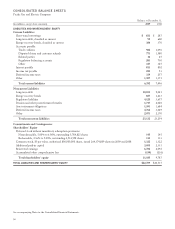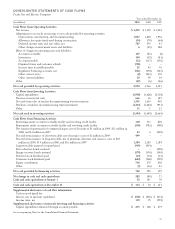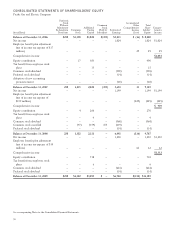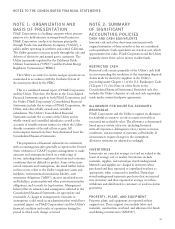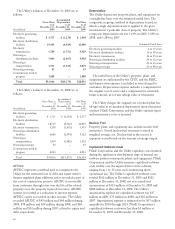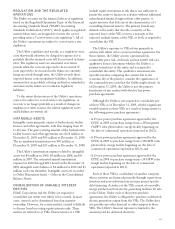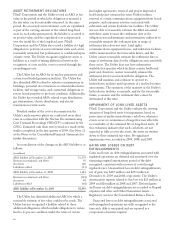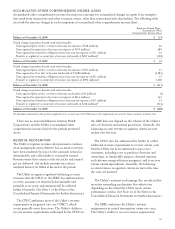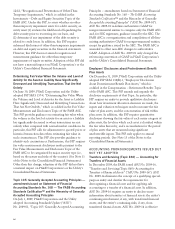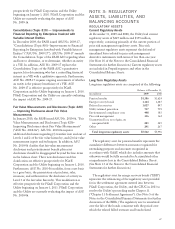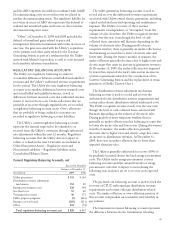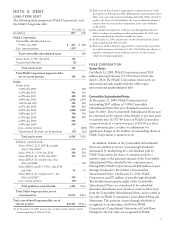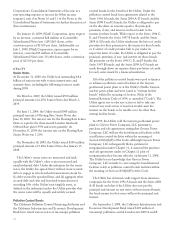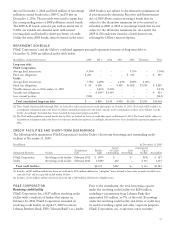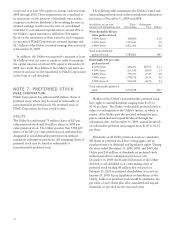PG&E 2009 Annual Report Download - page 70
Download and view the complete annual report
Please find page 70 of the 2009 PG&E annual report below. You can navigate through the pages in the report by either clicking on the pages listed below, or by using the keyword search tool below to find specific information within the annual report.124-2, “Recognition and Presentation of Other-Than-
Temporary Impairments,” which is codified in the
Investments — Debt and Equity Securities Topic of the
FASB ASC. Under this FSP, to assess whether an other-
than-temporary impairment exists for a debt security, an
entity must (1) evaluate the likelihood of liquidating the
debt security prior to recovering its cost basis, and
(2) determine if any impairment of the debt security is
related to credit losses. In addition, this FSP requires
enhanced disclosures of other-than-temporary impairments
on debt and equity securities in the financial statements.
However, this FSP does not amend recognition and
measurement guidance for other-than-temporary
impairments of equity securities. Adoption of this FSP did
not have a material impact on PG&E Corporation’s or the
Utility’s Consolidated Financial Statements.
Determining Fair Value When the Volume and Level of
Activity for the Asset or Liability Have Significantly
Decreased and Identifying Transactions That Are Not
Orderly
On June 30, 2009, PG&E Corporation and the Utility
adopted FSP SFAS 157-4, “Determining Fair Value When
the Volume and Level of Activity for the Asset or Liability
Have Significantly Decreased and Identifying Transactions
That Are Not Orderly,” which is codified in the Fair Value
Measurements and Disclosures Topic of the FASB ASC.
This FSP provides guidance on estimating fair value when
the volume or the level of activity for an asset or a liability
has significantly decreased or when transactions are not
orderly when compared with normal market conditions. In
particular, this FSP calls for adjustments to quoted prices or
historical transaction data when estimating fair value in
such circumstances. This FSP also provides guidance to
identify such circumstances. Furthermore, this FSP requires
fair value measurement disclosures made pursuant to the
Fair Value Measurements and Disclosures Topic of the
FASB ASC to be categorized by major security type (i.e.,
based on the nature and risks of the security). (See Note 11
of the Notes to the Consolidated Financial Statements.)
Other than this change, adoption of this FSP did not have
a material impact on PG&E Corporation’s or the Utility’s
Consolidated Financial Statements.
Topic 105: Generally Accepted Accounting Principles —
amendments based on Statement of Financial
Accounting Standards No. 168 — The FASB Accounting
Standards CodificationTM and the Hierarchy of Generally
Accepted Accounting Principles
On July 1, 2009, PG&E Corporation and the Utility
adopted Accounting Standards Update (“ASU”)
No. 2009-01, “Topic 105: Generally Accepted Accounting
Principles — amendments based on Statement of Financial
Accounting Standards No. 168 — The FASB Accounting
Standards CodificationTM and the Hierarchy of Generally
Accepted Accounting Principles” (“ASU No. 2009-01”).
ASU No. 2009-01 re-defines authoritative GAAP for
nongovernmental entities to comprise only the FASB ASC
and, for SEC registrants, guidance issued by the SEC. The
FASB ASC is a reorganization and compilation of all then-
existing authoritative GAAP for nongovernmental entities,
except for guidance issued by the SEC. The FASB ASC is
amended to effect non-SEC changes to authoritative
GAAP. Adoption of ASU No. 2009-01 only changed the
referencing convention of GAAP in PG&E Corporation’s
and the Utility’s Consolidated Financial Statements.
Employers’ Disclosures about Postretirement Benefit
Plan Assets
On December 31, 2009, PG&E Corporation and the Utility
adopted FSP SFAS 132(R)-1, “Employers’ Disclosures
about Postretirement Benefit Plan Assets,” which is
codified in the Compensation — Retirement Benefits Topic
of the FASB ASC. This FSP amends and expands the
disclosure requirements of that Topic. In particular, this
FSP requires an entity to provide qualitative disclosures
about how investment allocation decisions are made, the
inputs and valuation techniques used to measure the fair
value of plan assets, and the concentration of risk within
plan assets. In addition, this FSP requires quantitative
disclosures showing the fair value of each major category of
plan assets, the levels in which each asset is classified within
the fair value hierarchy, and a reconciliation for the period
of plan assets that are measured using significant
unobservable inputs. This FSP only applies to annual
reporting periods. (See Note 13 of the Notes to the
Consolidated Financial Statements.)
ACCOUNTING PRONOUNCEMENTS ISSUED BUT
NOT YET ADOPTED
Transfers and Servicing (Topic 860) — Accounting for
Transfers of Financial Assets
In December 2009, the FASB issued ASU No. 2009-16,
“Transfers and Servicing (Topic 860)—Accounting for
Transfers of Financial Assets” (“ASU No. 2009-16”). ASU
No. 2009-16 eliminates the concept of a qualifying special-
purpose entity and clarifies the requirements for
derecognizing a financial asset and for applying sale
accounting to a transfer of a financial asset. In addition,
ASU No. 2009-16 requires an entity to disclose more
information about transfers of financial assets; the entity’s
continuing involvement, if any, with transferred financial
assets; and the entity’s continuing risks, if any, from
transferred financial assets. ASU No. 2009-16 is effective
66


